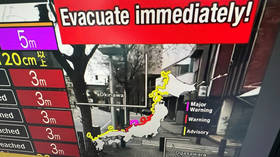Japan issues first ‘megaquake’ warning

The Japan Meteorological Agency (JMA) issued its first-ever “mega earthquake caution” on Thursday, following a magnitude 7.1 temblor that struck earlier in the day off the coast of Kyushu, the country’s third largest island. There were no immediate reports of serious damage or injuries.
The quake occurred at around 4:43 pm local time (07:43 GMT) off the coast of the Miyazaki prefecture of Kyushu, at a depth of about 18 miles, triggering tsunami advisories, the JMA said.
Seismologists reportedly held an emergency meeting to analyze whether the quake had impacted the nearby Nankai Trough, where it has long been feared that a massive earthquake could cause hundreds of thousands of deaths. Large earthquakes have taken place every 100 to 150 years in central and western parts of Japan, the agency said.
According to Japan Forward, the government predicts a megaquake at the Nankai Trough within the next 30 years with 70-80% probability.
After the Thursday temblor, the JMA said that the “possibility of a large-scale earthquake is considered to be relatively higher than under normal conditions.” It urged residents to be on higher alert for the next week.
Japan’s Nuclear Regulation Authority confirmed that all 12 nuclear reactors on Kyushu and Shikoku islands are safe.
The massive 9.0-magnitude earthquake and subsequent tsunami that struck Japan in March 2011 left 18,000 dead and triggered the Fukushima nuclear disaster.
Japan sits on the ‘Ring of Fire,’ a line of seismic faults encircling the Pacific Ocean, and is one of the world’s most earthquake-prone countries.
More than 240 people died and tens of thousands of homes were destroyed in January, when a 7.6-magnitude tremor hit the Noto peninsula in the western part of the country.












